“Do you know how to read the financial statements?” is the question that new investors always feel helpless about.
“I know I should read financial statements as a stock investor. But how?”
“I don’t know any accounting stuff, how could I understand anything in those reports?”
Been there, done that. I can totally relate to your frustration.
To learn it myself, I read several investing books and articles on the Internet. When I started to get the hang of it, it isn’t as complicated as I expected.
In this article, I will explain how to read a financial statement as a stock investor in the simplest way ever. After this, I hope you are able to grab the company’s story behind those numbers.
Disclaimer:
I am not a certified financial advisor or professional. This information is compiled from my own research and sharing. Any stock shown in the case studies is not a recommendation to buy or sell. Please do your own due diligence if you want to invest in any stock.
What You Will Expect From This Article
Firstly, this article is super comprehensive that requires at least 15 minutes to read.
For your sake of time, I will list out all the highlights from this article.
- The importance of knowing how to read a financial statement as a stock investor
- Understanding the accounting terms in the income statement, balance sheet, and cash flow statement.
- The metrics to analyze from financial statements.
- How to identify red flags from those financial metrics.
- How to look for the future prospect or outlook by the company management.
- Where to look for the financial reports of a company
This article does not include
- How to do stock valuation in the overall business
- How to calculate the intrinsic value of a stock
- The clue for “This stock still can buy?”
Okay, maybe there’s a clue for that, depending on how you interpret it.
Are you clear about what you’ll be reading?
Great! Let’s get started!
Financial Report vs Financial Statement
Before diving deep into the guide, it is better to know the differences between these two terms.
| Financial Reports | 1) Annual Report 2) Quarterly Report |
| Financial Statements | 1) Income Statement 2) Statement of Financial Position (Balance Sheet) 3) Statement of Change in Equity 4) Cash Flow Statement |
A financial report refers to the financial document published by the company quarterly or annually.
While a financial statement refers to the 4 statements mentioned above, which can be found in both reports.
In this guide, we will focus on financial statements (exclude the Statement of Change in Equity).
The Importance of Reading Financial Statements
You will read every detail and specs of a new smartphone before buying one.
But why don’t you read the company’s financial reports before buying its stock?
I don’t get it.
To be a well-informed investor, it is important to know how to read financial statements. By just reading those reports, we could acquire this information:
- The revenue or sales generated by the company.
- The details of the company’s profits or losses.
- The total cash and debts the company has right now.
- The cash flow for the past years (positive or negative).
- The trend of the company’s profit margins in the past few years.
- The future outlook of the company’s management team.
With this information, we can have a better look at one company’s financial status. This simplifies our decision-making as an investor in terms of buy, hold or sell the share.
Understanding the Financial Statements
Here is the checkpoint you should take a deep breath. Because it’s time to understand those accounting terms in financial statements.
Don’t worry, I try my best to explain with something relatable and easy to grasp.
Here are the definitions for each financial statement:
| Income Statement | Shows us how much profits the company make |
| Balance Sheet | Shows us how much the company worth |
| Cash Flow Statement | Shows us how much cash flow in or out of the company |
Now, what if we look at these statements from a personal finance perspective?
| Income Statement | Shows how much salary you received |
| Balance Sheet | Shows how much is your net worth |
| Cash Flow Statement | Shows how much cash you have left |
Income Statement
To simplify my explanation, let’s imagine that this is a small business selling Nasi Lemak.
It has a small shop by the road and hired a few youngsters to help out with the business. And here is the income statement for the Nasi Lemak business.
Revenue & Gross Profit

The total money earned from selling all the Nasi Lemak, we called it Revenue or Sales.
To prepare all these nasi lemak, they need to buy ingredients like rice, coconut milk, cucumber, chili, and so on. These expenses are known as Cost of Goods Sold (COGS) or Cost of Sales.
By deducting ingredient costs from revenue, we will get Gross Profit.
Profit Before Tax

But that’s not all. There are other expenses such as employee wages, delivery transport, rent, and utilities. These are usually known as Sales, General & Administration (SGA) expenses.
The business owner placed part of their cash in fixed deposits. So the interests generated are categorized as other incomes.
By deducting these SGA expenses and adding other incomes, we will get Profit Before Tax (PBT).
Profit After Tax
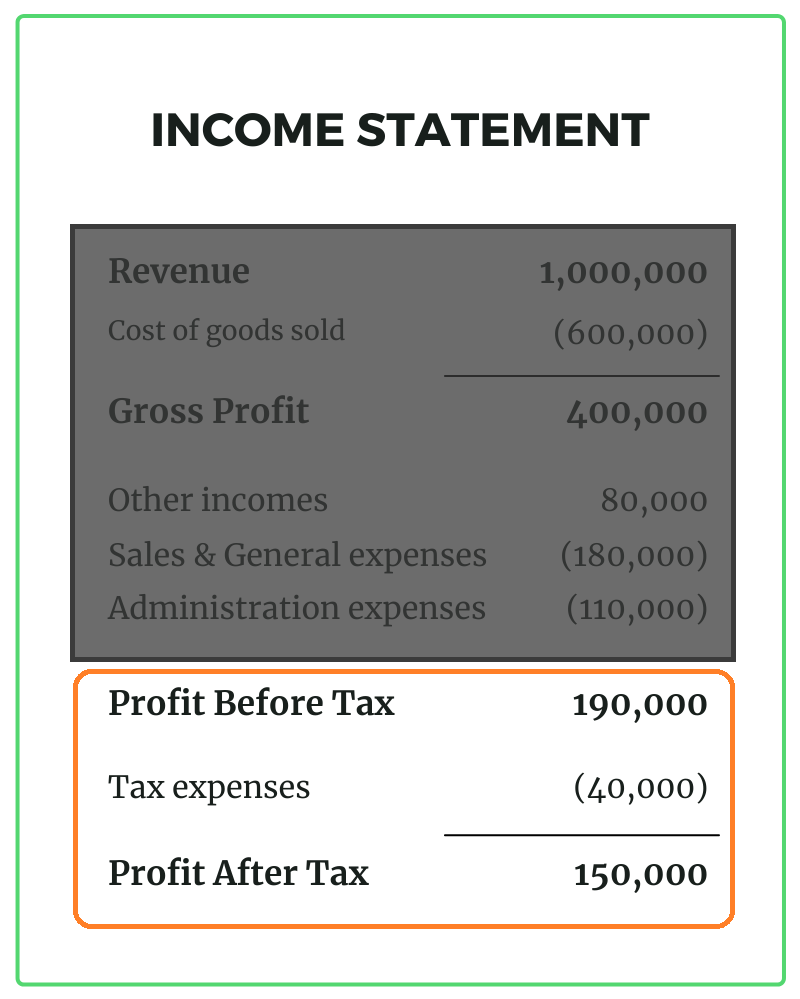
Obviously, every business needs to pay some tax. After deducting the tax, we will get Profit After Tax (PAT). It is also known as earnings, net profit, or net income.
To be frank, there are other terms like operating profits, EBIT, or EBITDA. But for the sake of simplicity, I just skip them.
Balance Sheet
In the balance sheet, we will surely see these 3 words: asset, liability, and equity. Let me briefly explain these terms.
| Asset | The items that increase the company values. |
| Liability | The items that decrease the company values. |
| Equity | The value of the company after assets minus liabilities |
So what are the assets and liabilities for a Nasi Lemak business?
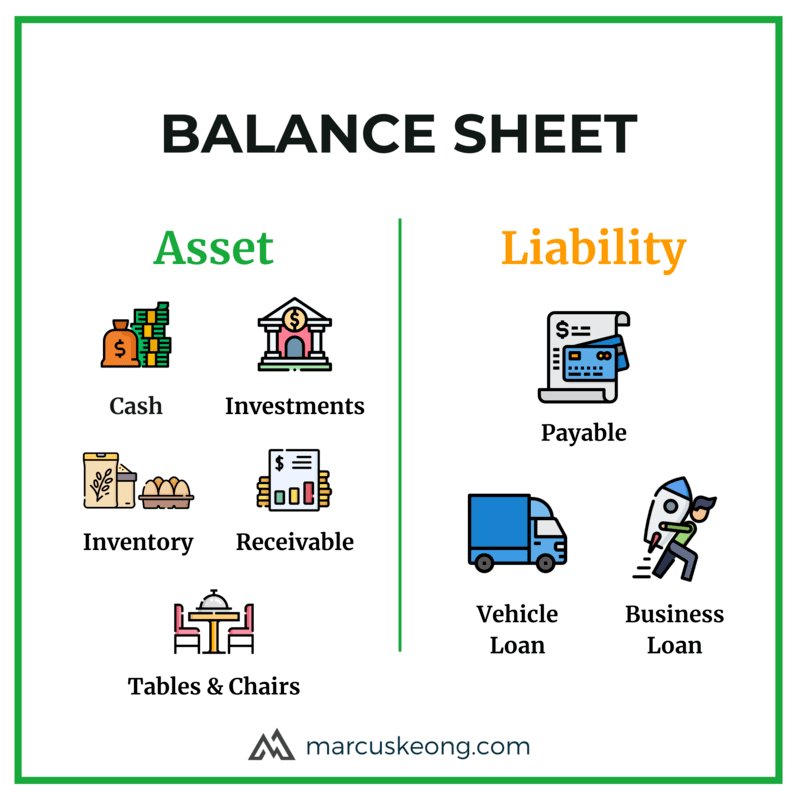
Assets: cash, investment (FD), rice & eggs (known as inventory), bulk orders by the customer but not paid yet (receivables), tables, chairs.
Liabilities: money owed to coconut milk supplier (payable), vehicle loan, business loan
Current Assets & Current Liabilities
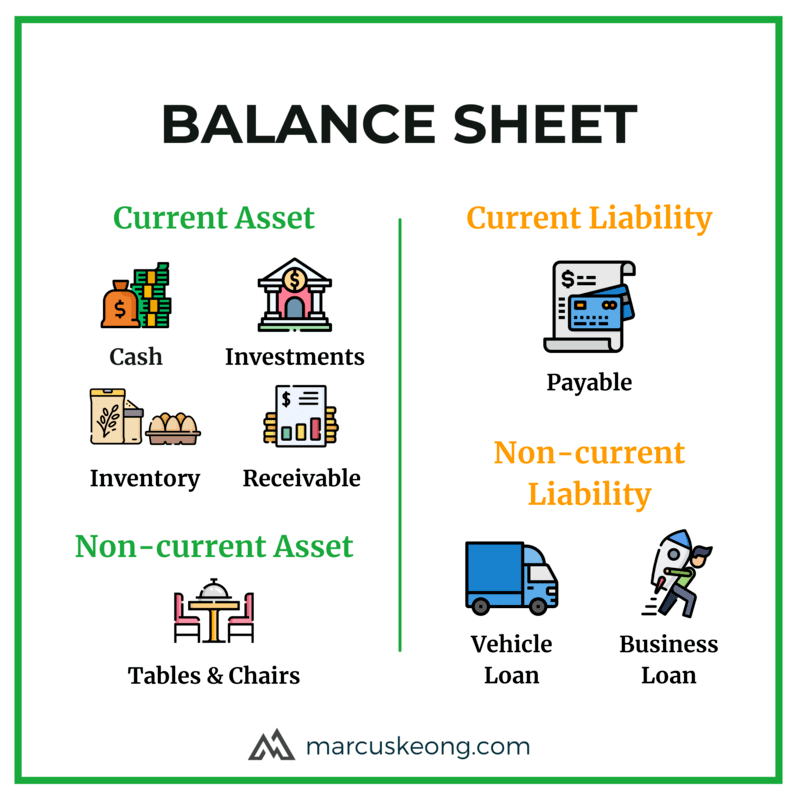
In assets and liabilities, we can divide them into two categories: current and non-current.
Current asset means the asset can be liquidated into cash in less than a year. The inventory (rice & eggs), receivables (money owed by customers), investments, and cash (duh!) are current assets.
While current liability is short-term obligations that are due in less than a year. In this case, the payable (money owed to the supplier) is the current liability.
For non-current assets and non-current liabilities, they are pretty self-explanatory when you understand current assets and liabilities.
Equity aka Shareholder’s Fund
When assets minus liabilities, we will have the equity. These are also known as the shareholder’s fund.
The business owner of the small nasi lemak told us that she is grateful for her parents, uncles, and aunties who willing to “invest” in her business.
Indirectly, they are known as the shareholders.

In the balance sheet, we will record the total equity. Over years, the equity amount will grow when the business grows. The accumulated earnings are known as retained earnings.
We can also view equity as the net worth of the company. The higher the assets or the lower the liabilities, the higher the net worth aka equity of the company.
Cash Flow Statement
In reality, the profits of a company aren’t all in cash. Hence, a cash flow statement is important as it shows us how much cash is flowing in or out of the company.
In the cash flow statement, it can be divided into 3 sections:
- Operating activities
- Investing activities
- Financial activities.
Cash Flow (Operating Profits)
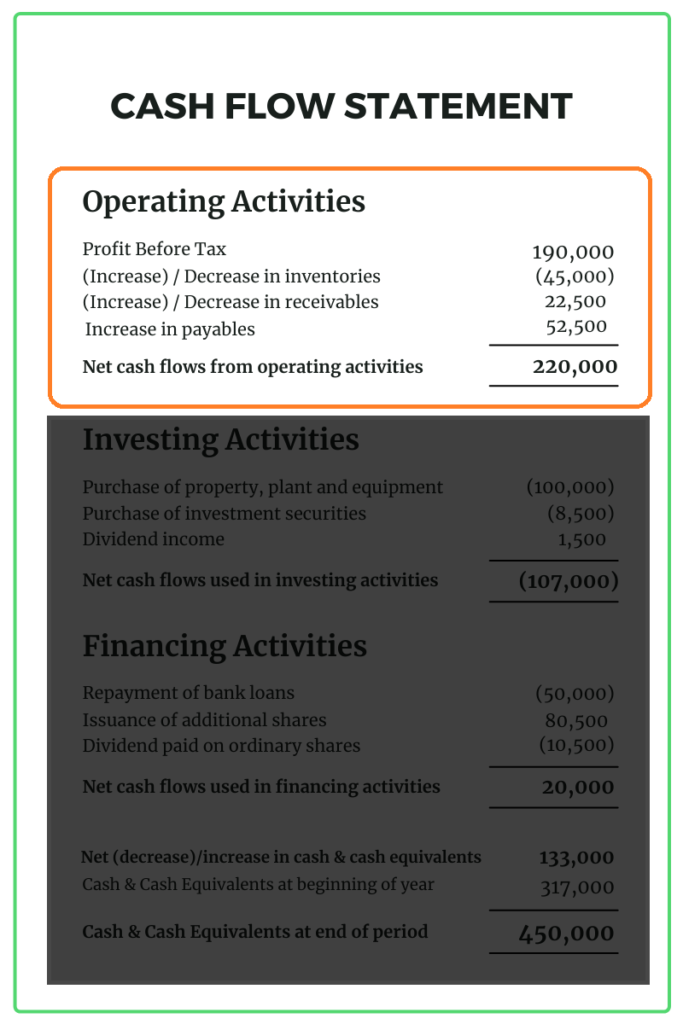
Operating activities involved all the cash in and cash out involved in business operation. The remaining cash after selling Nasi Lemak is known as cash flow or operating profits (if it is positive).
If the total return of the operating activities is negative (in loss), it means the company has more cash flowing out of business than flowing in.
Investing Activities
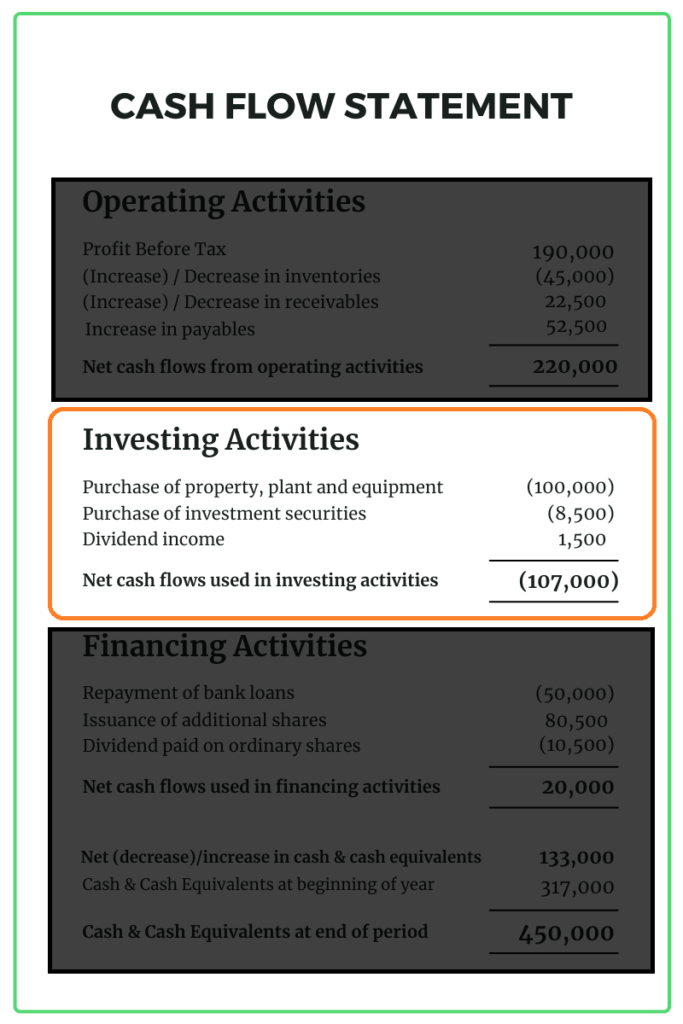
Investing activities usually refer to cash used to invest in capital expenditure or making investments such as Fixed Deposits. It also includes cash return from investment such as interest, dividend, or liquidation (sell-off).
Capital Expenditure aka Capex
While doing business, companies may invest some money to keep their business running. These expenses are known as capital expenditure aka CapEx.
The CapEx usually can be found as “Acquisition/Purchase of property, plant, and equipment” in the cash flow statement.
Capital expenditure (aka Capex) can be categorized into maintenance and development.
Maintenance is the common one for a business, such as tables & chairs replacement, employee training, or shop maintenance.
Development involves business expansion such as the purchase of new shops or recipe research on new Nasi Lemak menus.
Sadly, both categories usually lump sum together in the financial statements. So we can’t really differentiate the Capex for maintenance and development in a real statement.
Well, at least you understand more about CapEx.
Financial Activities
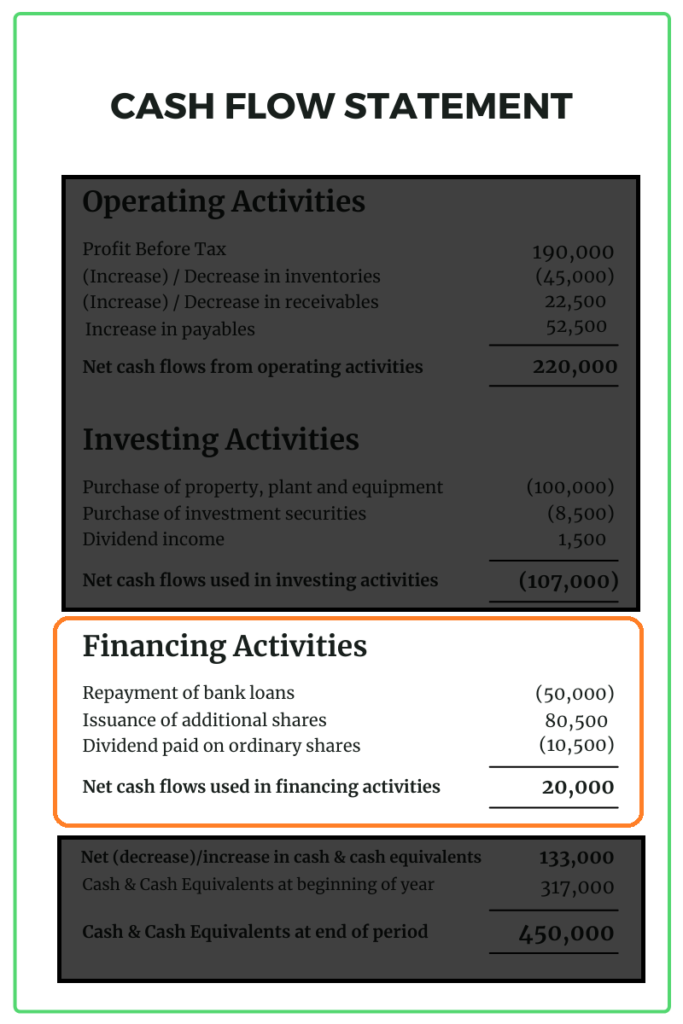
Financial activities involve cash in and out that are related to financial institutions or company shares such as bank borrowing, debt payment, issuance of additional shares, or dividends paid.
If the nasi lemak business applied for a business loan, then it will be written here as cash in.
Cash & Cash Equivalents

We will see the total cash and cash equivalents for the quarter or year at the end of the statement. This indicates how much cash left in the business.
The 5 Metrics I Always Use
Phew! We’re done with the financial statements. Are you still with me?
I understand it might be too much to digest. But no worry, my article will go nowhere. So feel free to read it again.
Next, what information we want to obtain from these financial statements?
I will share the 5 important metrics I personally use to see if a company has solid financial status.
Revenue Growth > 10%
Revenue or sales is basically the most essential part of a business. No revenue, no business.
The trend we expect to see from a good business is its revenue continue to increase over years.
If the revenue remains stable, then you can only expect to get a dividend-like return. Like 4% to 6%.
If the revenue goes down, need me to say more? That’s an obvious red flag.
In short, we want to invest in a company with a business that grows over time. When we invest in companies with such criteria, our money will surely grow along with the business.
Earnings Growth > 10%
Aside from revenue, earnings growth plays an important part too.
If a company has revenue growth but also increasing expenses, then its earning growth will be slow or none. It shows that the management couldn’t control the cost of their business. We wouldn’t want that.
Low earnings also mean less or no dividend for us. A red flag there. Therefore, both earnings and revenue are important metrics.
Also, be aware of sudden jumps in earnings. We should understand the reason behind those super high earnings growth like 50% to 100%.
If the earning is not reasonable or sustainable, then it is nothing to be excited about. I’ll be more skeptical about that company.
Slow and steady is the key to let us investors grow wealth over the long run.
Debt-Equity Ratio < 40%

Debt to equity ratio also known as Gearing Ratio. It measures a company’s borrowings by using shareholder funds as the benchmark.
These are the criteria I expect to see from this metric:
- Less than 40%
- Slowly decreasing
Before I look into the debt-equity ratio, I will usually check the company’s cash equivalents. If it has more cash than debts, then we can skip this metric.
It is safe to know that the company can pay off all its debts with cash.
If a company has a ratio higher than 40%, it means the company borrows too much on managing its business. Too many debts will lead to bankruptcy if not handled well.
So it is a red flag for me if it has debt higher than 40%.
Quality of Income (QOI) > 80%

Quality of income gives us clarity on how much cash the company received from its earnings. Cash flow refers to its operating profit, the total cash received from its business.
These are the criteria I expect to see from this metric:
- At least 80% and above
- Consistent
If the ratio is higher than 1, it means the company has more cash flow than its earnings, which is a good thing.
QOI allows us to see how much earnings are obtained in cash. If the company has high earnings but QOI shows below average, we can say the quality of income from that company isn’t good.
The worse? A negative QOI. Its report shows earnings but cash flowing out instead, that’s a red flag.
Positive Free Cash Flow (FCF)

If we take cash flow minus capital expenditure, we will get free cash flow. This metric shows the cash flow generated from a business after deducting the expenditure cost.
These are the criteria I expect to see from this metric:
- Positive over the years
- If negative, find out why (Land acquisition? Tax imposed?)
- Avoid constantly negative for years
Cash is the blood for a company to keep operating, so the more the merrier. More cash means more choices for a company. Either for business expansions or to withstand financial crises such as the Covid-19 pandemic.
There is an exception case though. A cash-rich company may have high CapEx and ended up with several years of negative FCF.
If the company has great ratios on the 4 metrics above, I will still consider investing in it.
Other than that, constantly negative FCF is a red flag for me.
Return on Equity (ROE) > 15%

Return on equity is an extra metric that I check if all 5 metrics have green ticks.
It measures how much profits generated for every dollar of the shareholder’s fund. It gives us information on how capable the company is to generate income.
These are the criteria I expect to see from this metric:
- At least 15%
- Consistent or increasing trend
Frankly speaking, even if the ROE is lower than 15%, I may still consider investing in that company if it has strong management and a solid business model.
For me, ROE is not useful when the company has some losses in the last few quarters. So even the ROE isn’t meet the criteria I mentioned above, there will not any red flag.
Case Study on One Malaysian Company
To familiarize ourselves with financial statements, a case study will be helpful. Therefore, I will choose one company that I understand to walk you through its financial statements.
Time Dotcom

For those who live in KL or Penang, you will be quite familiar with this company – Time Dotcom. As TM Unifi’s biggest rival, this company provides Internet packages with faster speed yet competitive price.
A disclaimer here. I have invested in this company since last year. As I already did some research, it will be easier for me to use this company as a case study.
Extract The Financial Figures For 10 Years

Huh? Need to collect 10 years of data?
Yes. You see nothing with just 1 or 2 years of data. The longer the time period, the better we can observe how the company performed in the past.
If I can’t get 10 years of data, 5 years is the minimum.
From the table above, these are the financial figures I usually record:
- Revenue
- Profit Before Tax
- Profit After Tax (Net Income/Earning)
- Borrowings/Debts/Loans
- Equity
- Operating Profits (Cash Flow)
- Capital Expenditure
- Cash Equivalents
Personally, I prefer to get the annual financial figures from the 4th quarterly report.
Here is how I get each number from Time Dotcom’s financial statement:
1) Income Statement
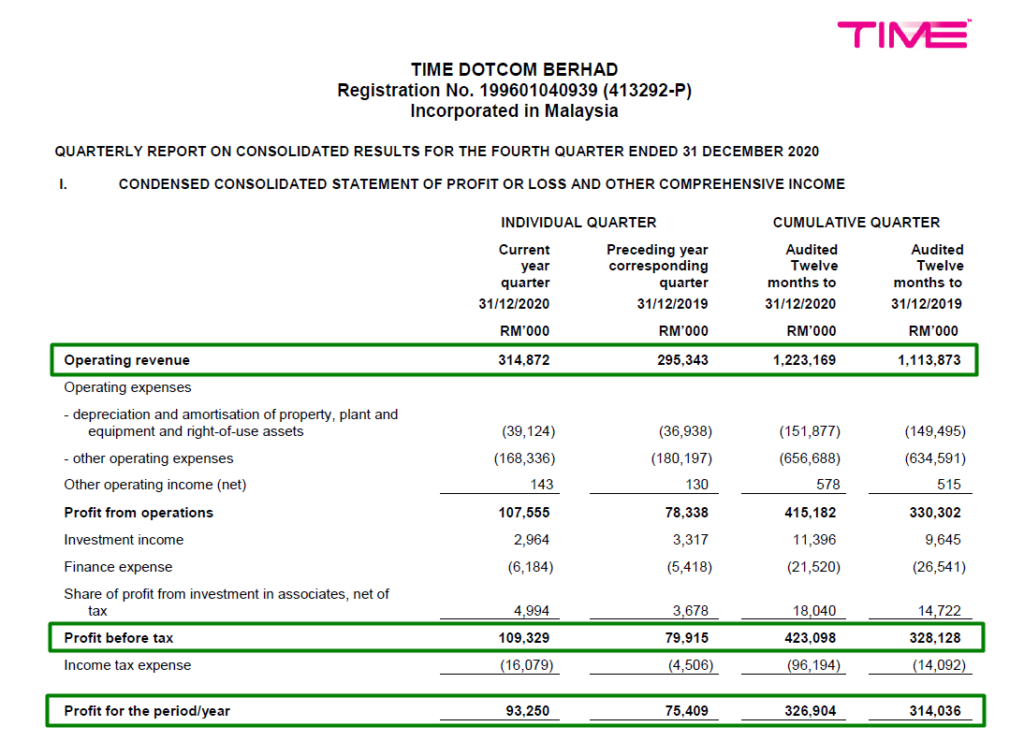
In the income statement, we can easily get revenue, profit before tax, and profit after tax (Profit for the year). To get the annual figure, we just focus on the numbers under “Cumulative quarter”.
For the year 2020, these are the figures:
- Revenue: RM1,223,169k
- Profit Before Tax: RM423,098k
- Profit After Tax: RM326,904k
2) Balance Sheet
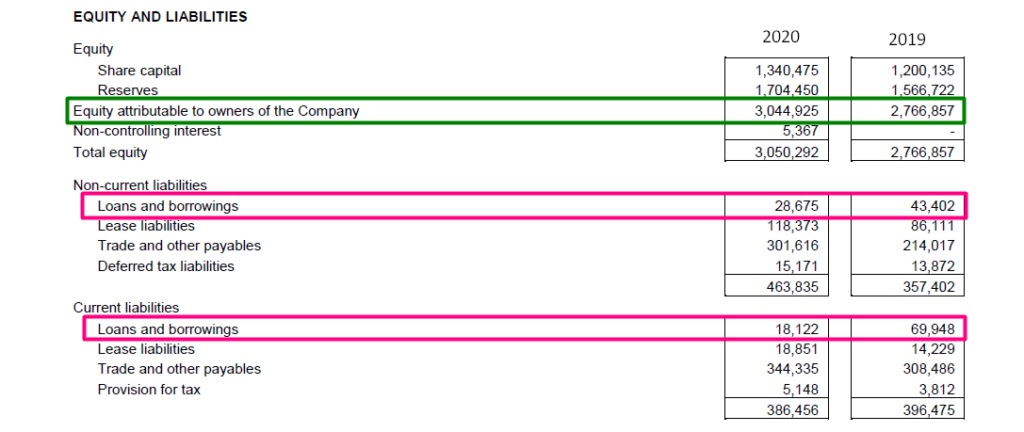
In the balance sheet, we can find the value of equity and total borrowings.
You can observe that I usually exclude “Non-controlling interest” from Equity value. Because there are subsidiary corporation’s stocks that are not fully owned by the company.
For borrowings, we need to add up both loan figures from non-current and current.
For the year 2020, these are the figures:
- Equity: RM3,044,925k
- Borrowings: RM46,797k (28,675 + 18,122)
3) Cash Flow Statement

In the cash flow statement, we will look for cash flow (operating profits), capital expenditure (CapEx), and total cash equivalents.
The CapEx usually can be found as Acquisition/Purchase of property, plant, and equipment. (Short form PPE)
For the year 2020, these are the figures:
- Cash Flow: RM641,233k
- Capex: RM282,609k
- Cash Equivalents: RM748,796k
Now we have all our figures for 2020, do the same things for 2011 to 2019.
Tips: You can get 2019 data from the 2020 4th quarterly report as well. So you only need to check 5 reports to get 10 years of data.
Revenue Growth
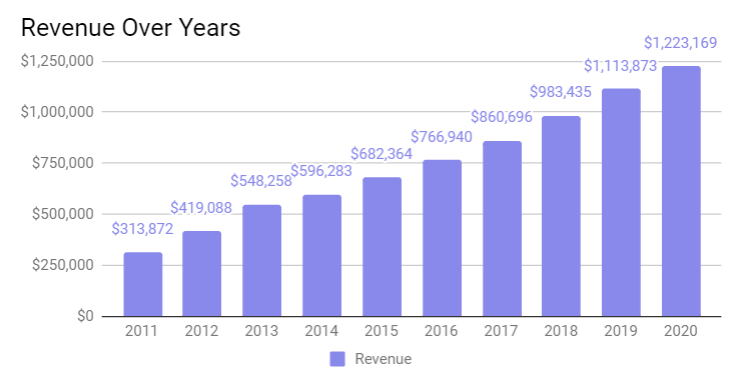
When we have all the numbers, we plot charts to visualize their trend.
For Timecom, its revenue rose from RM314 mils to RM1,223 mils in 10 years. It is obviously the kind of graph we like to see.
But I want to know the exact growth rate for each year. So I have calculated the revenue growth rate for each year and plot them into another graph.
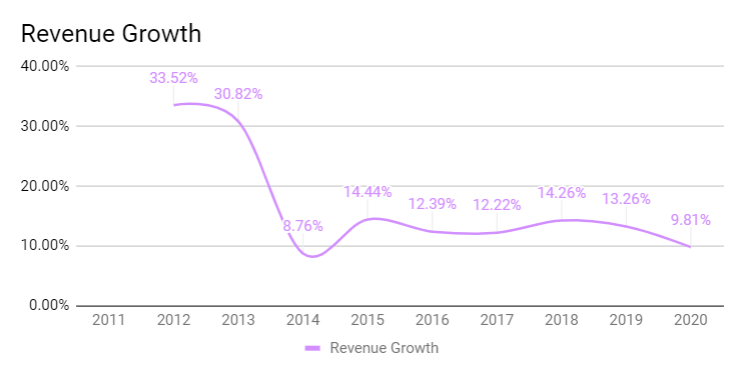
We can see that the revenue growths are super in 2012 and 2013. Then from 2014 onward, it hovers from 8.76% to 14.44%, which met my expectation of average 10% revenue growth.
Earnings Growth
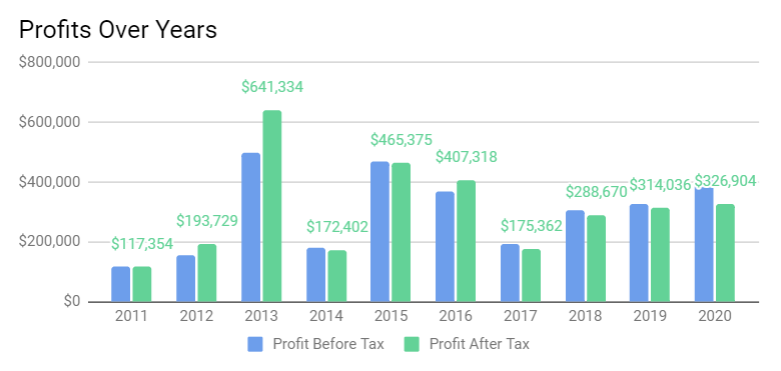
From the bar chart, we notice that 2013, 2015, and 2016 have surprisingly high profits. To understand that, we need to dig into its financial reports for more info.
I’m not going through that. Else the article will be never-ending. So go check by yourself if you are interested.
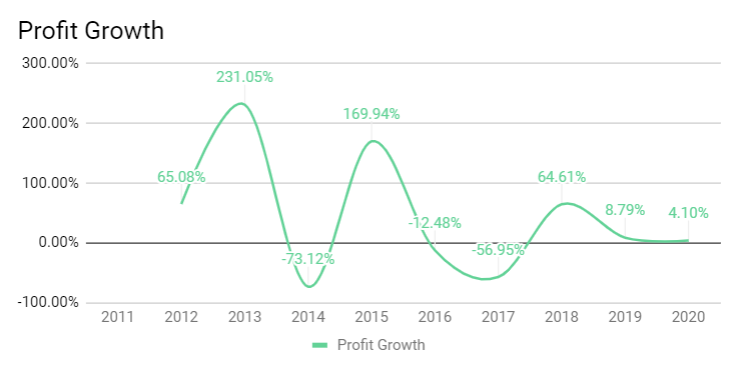
By looking at its profit growth graph, we can’t really be sure if it met the 10% annual growth. So the best way is to calculate its CAGR (Compound Annual Growth Rate) from 2011 to 2020.

Cumulative Annual Growth Rate (CAGR) allows us to see the “average” annual growth rate between 2 figures for a certain period of time. Nevertheless, Time Dotcom’s profit growth of 12.06% matched our requirement for a good company.
If you are interested in its formula, here it is.

Debt-Equity Ratio
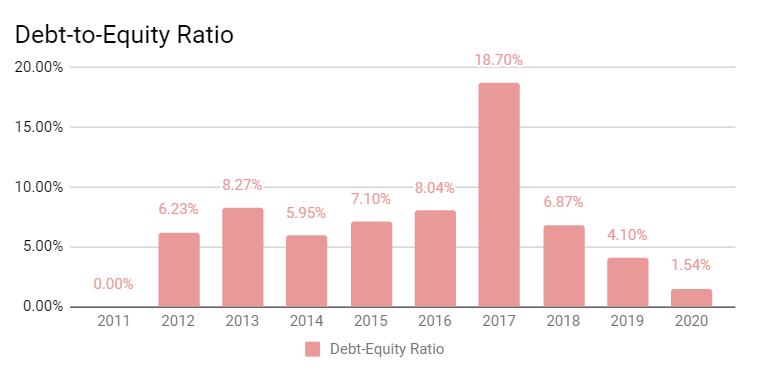
Next, we look at their debt vs equity. We can see that its debt never exceeds 20% of its equity for the past 10 years.
This is a good sign as Time Dotcom didn’t borrow too much money for its operation. Huge borrowings will reduce a company’s cash flow due to high interest.
But before I look into the Debt-Equity ratio, I usually like to look at the company’s cash.

From the graph, it is clearly shown that the company always has enough cash to pay off all its debt. By knowing that, we can literally skip looking at its debt-equity ratio. How convenient right?
Quality of Income
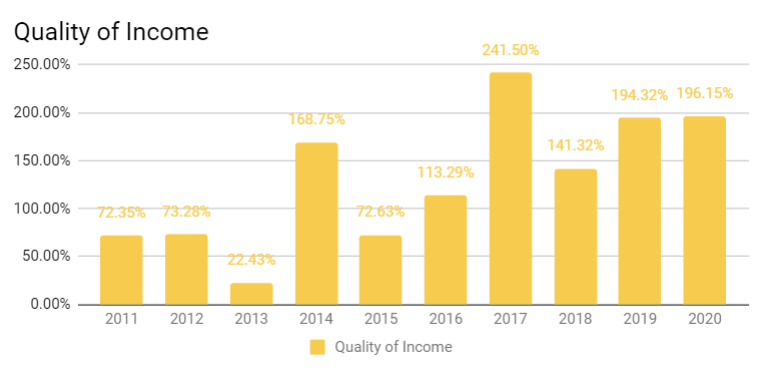
There are fluctuations in the company’s quality of income across years. But we can see its quality of income is getting better.

To have more visibility, I love to look at the area chart between its earnings and cash flow. We can see that 2013, 2015, and 2016 earnings spikes made QOI looks low. But in reality, the cash flow is increasing over the years and eventually more than earnings.
This is a good sign that the company has more positive cash flow than its earnings.
Free Cash Flow
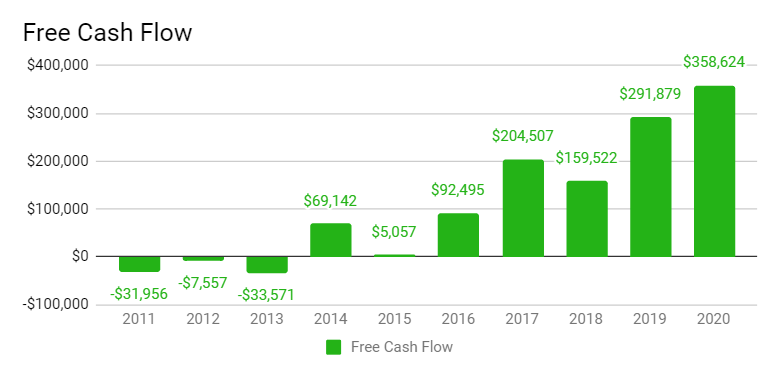
From the graph, it seems that the free cash flow of Time Dotcom is increasing exponentially. This is the result of cash after deducting the CapEx. Like I said before, cash is like the blood for the company that keeps it running.
Hence this is a good sign for a company with healthy financial status.
Return on Equity
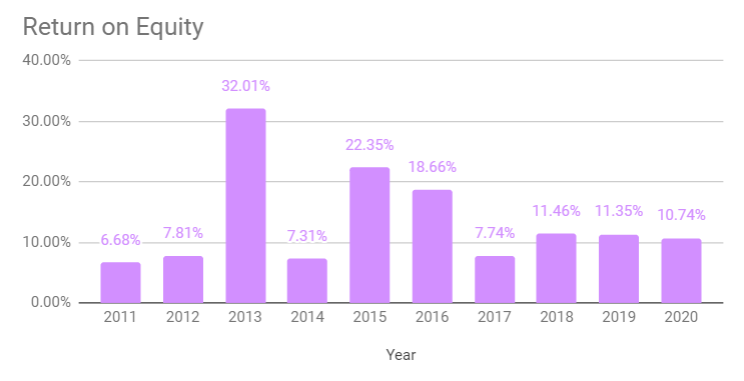
From the RoE graph, we can notice that 2013, 2015, and 2016 have RoE of more than 18%. This is due to the high earnings that we notice earlier.
To be fair, I will usually exclude these 3 years when calculating its average RoE.
Overall, RoE of Time Dotcom is hovering around 7% to 11%.
Case Study’s Conclusion
By analyzing all the financial metrics, we manage to observe Time Dotcom from different financial angles. Is the company fundamentals good enough to invest in?
Well, it’s up to you to decide. You should always have your own due diligence, right?
The 10-Minutes Quick Screening
To quickly scan through all the listed stocks, it will be time-consuming if we need to fully analyze each company.
So I’m sharing with you tips on what are the 3 things I look for before I decide to deep dive into the company’s fundamentals:
- Revenue Annual Growth > 10%
- Debt Equity Ratio < 40% (or Cash vs Debt)
- Quality of Income > 80%
To look at the revenue growth at one glance, I love to use KLSE Screener App. It already provides us with all the data of revenue and earnings annual growth, without us doing it manually.
I wrote on how I scan through hundreds of stocks with the app, so you can check out my article here: A Comprehensive Guide on How to Use KLSE Screener App
Clues on Company Future Outlook
To be honest, it is not enough to look at one company’s financial fundamentals. We also need to understand its business prospect and management’s capability.
Well, good news for you. The statements are not the only thing in the financial reports.
The true gem of reading the financial reports is we can also get clues on the company’s future prospects. I will show you how to look for these clues in both the quarterly report and annual report.
Quarterly Report

Usually, you can find the future prospect section right after “Review Performance” and “Comparison with Previous Quarterly Results”. It is usually titled “Prospect” or “Future Prospect”.
Though you might find some companies don’t provide many details in quarterly financial reports. Some just copy and paste from the previous quarterly report. So I usually prefer to read the annual report to understand more about the company.
Annual Report
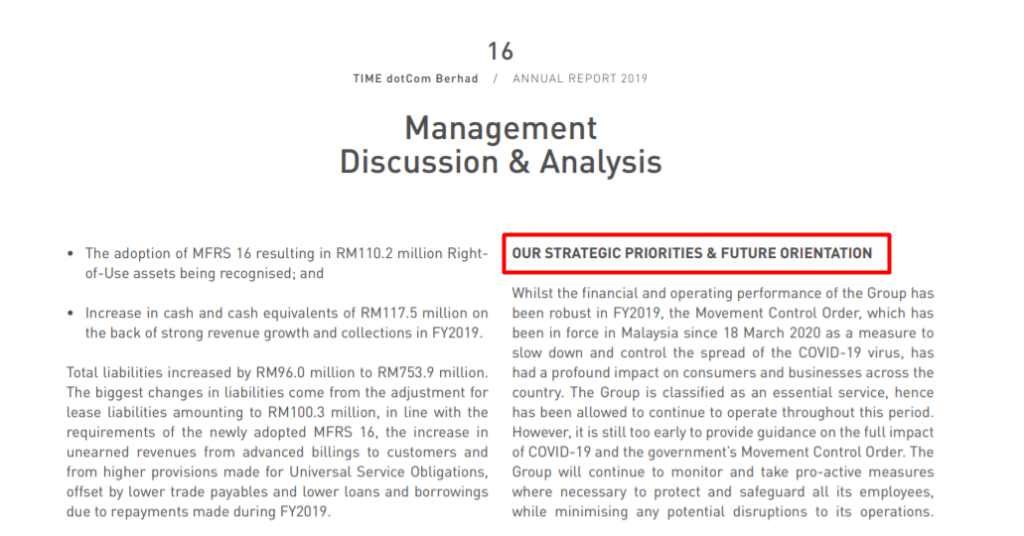
Before you dive into the report, go to the content index page. Look for the section of “Chairman’s Statement” or “Management Analysis”. Then scan for these sub-titles “Future Outlook”, “Prospect” or “Future Orientation” within these sections.
Where to Find The Financial Report of a Company
For Malaysian stocks, there are two ways to look for financial reports.
1) Bursa Website
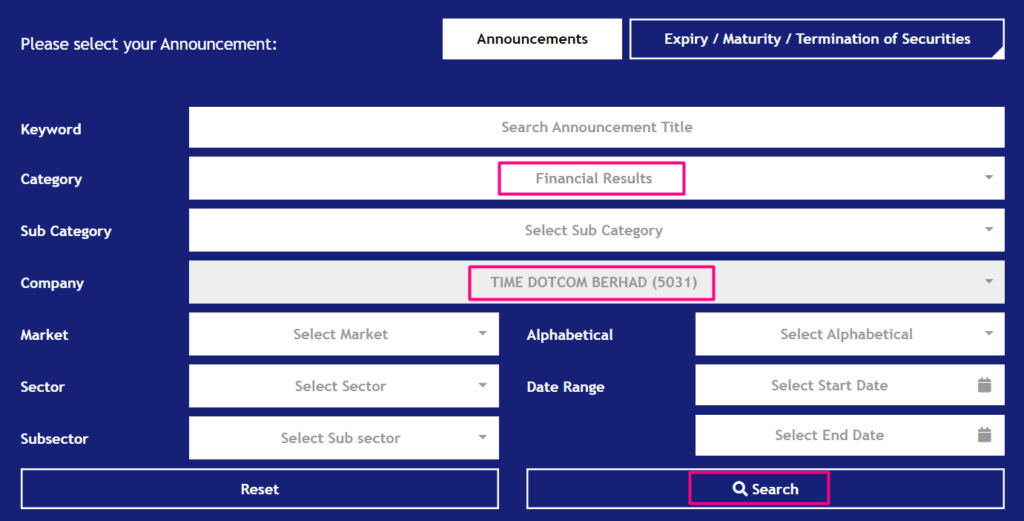
For Malaysian Stocks, you can easily find all of them on the Bursa website. Just select “Annual Report” or “Financial Results” at Category, then key in the company name and click “Search”.
2) KLSE Screener App
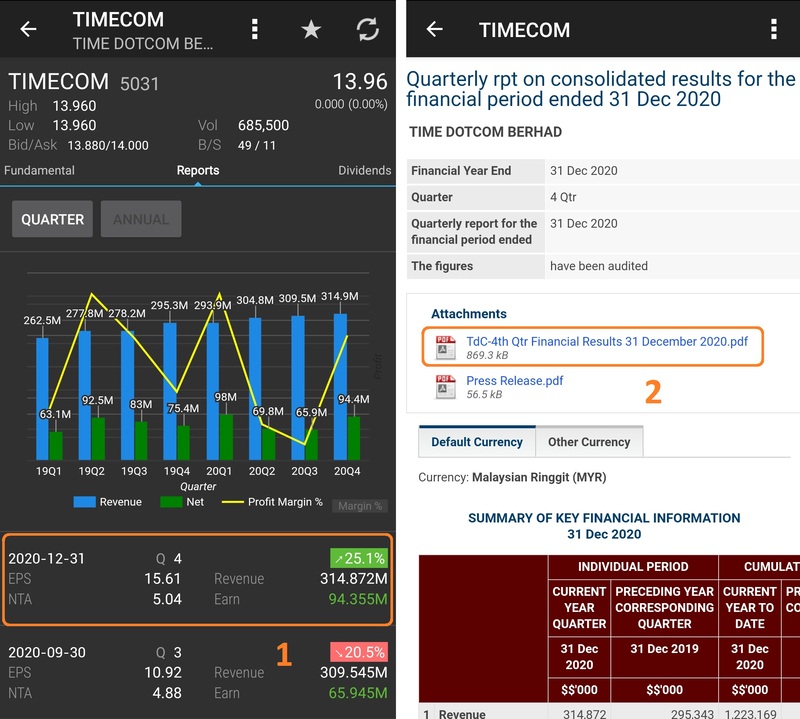
Another method is by using KLSE Screener App. You can easily find the reports under a specific stock. Tap on one of the results and you will be redirected to the Bursa page with report attachments.
Verdict
Learning how to read financial statements is one big step to becoming an independent stock investor. But it is not the only thing you need to choose a great stock.
Frankly, understanding the company’s financial statement only tells you one-third of the story. A company that is worth to invest comprises of these 3 things:
- Strategic Business Model
- Reliable Management
- Solid Fundamentals
Now you acquire the skill of fundamental analysis and are better than 80% of the stock investors.
I hope this article will help you in your stock investing journey. All the best!

Hi thanks a lot for sharing. learn alot from your blog.
I have subsribed and wondering where can i get your link to the spead sheet that you have shared? Can you share with me?
Hi, thanks for your subscription. I believe I have replied to your email regarding the spreadsheet. 🙂
hey marcus, great article! it showed me a lot of insight into stock picking. i was wondering where the spreadsheet could be available?
Hi, you can get my spreadsheet by subscribing to my blog. 🙂
Thanks for sharing Marcus! This helps alot
You’re most welcome! Always glad to help!